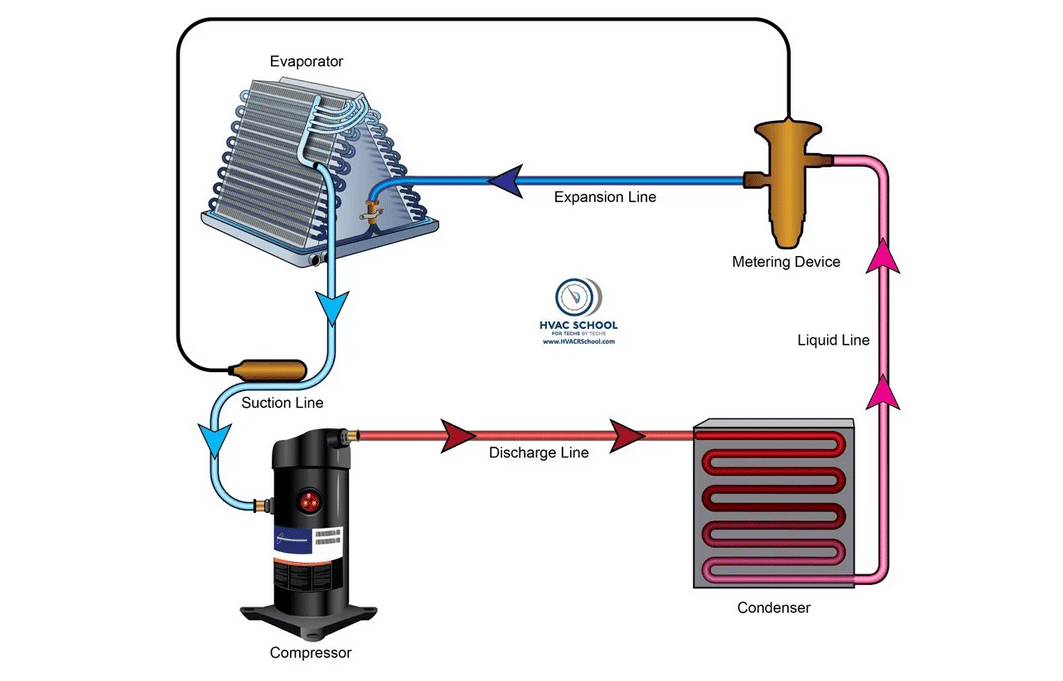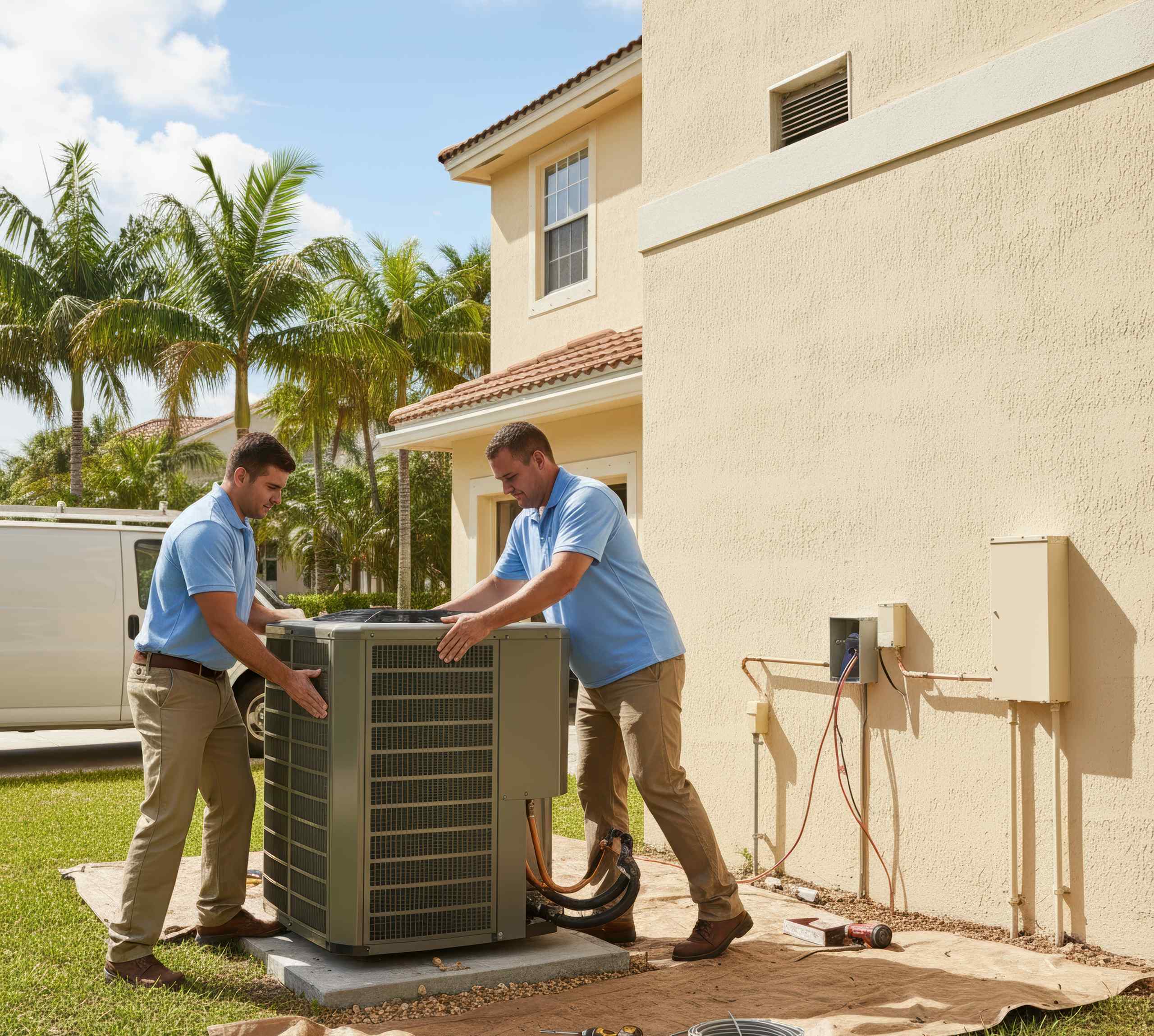If your air conditioning is not blowing cold air but running, there’s probably no need to tell you that you have a problem. Southwest Florida homes quickly turn into saunas without functioning AC and a system that’s blowing warm air is a sign that your AC needs a tune-up or repairs.
The bad news? It could be one of about 9 or 10 reasons causing the lack of cold air. The good news? We’ll help you troubleshoot them all—and most are not too serious.
Let’s take a look at the main reasons why your air conditioning is failing to blow cold air. We’ll cover the following:
Air conditioner not blowing cold air but running: main reasons

When our service technicians are called out by Florida home or business owners to repair AC units with a “no cold air” problem, it’s usually down to the thermostat, a frozen evaporator coil, a clogged air filter, a dirty or blocked condenser unit, leaky ductwork or a refrigerant leak.
Most of these issues have relatively simple fixes that keep the repair bill very manageable. Sometimes, however, more serious problems occur. An old system with worn-out parts or an incorrectly sized unit is the root cause of many problems—and these issues are a little more expensive to fix.
You may even need an AC replacement. New AC costs in Florida can involve a hefty investment but, generally speaking, money spent upfront on selecting and installing a quality cooling system pays dividends for many years afterward.
STAY COOL ALL YEAR ROUND WITH ONE WAY AIR…
The team at One Way Air installs, services, and repairs all types of air conditioning systems in Southwest Florida. Get in touch with us here for a quote or call 239-233-4356 in emergencies.
How does AC work?
Before we look more closely at the main reasons why your AC may be running but not blowing cold air, let’s remind ourselves of the basics of how home cooling systems work.

An air conditioning system works because of two main processes: refrigerant chills the indoor air (when a liquid converts to a gas, it absorbs heat) and the resulting gas is then pressurized by the compressor and cooled for conversion back to a liquid again. Heat is released outside the home and the inside air is cooled.
This evaporation and condensation process occurs repeatedly and relies on the free flow of air in the right directions and the right equipment all working together. When there are blockages or interruptions to these processes, problems may arise and cooling power is lost or reduced.
Troubleshooting why your AC is not blowing cold air
Now you know what your AC should be doing, it may be easier to pinpoint why it’s not doing that.
If your AC is blowing out warm air and not cooling your home to the desired temperature, it’s not only making you and your family uncomfortable; it’s also wasting electricity and maybe shortening the life of your system.
Here are the main reasons why it might be happening:
A faulty or incorrectly set thermostat
One of the most basic reasons why your AC is not blowing cold air when running is an incorrectly set thermostat.
The thermostat is responsible for controlling the temperature of your home. Sometimes, it is not calibrated properly or gets adjusted by accident and the system fails to blow cold air.
It’s one of the first places to check. Make sure the thermostat is set to AUTO and the desired temperature. Also, check that the batteries are working.

If you turn down the thermostat and still find that the AC fails to blow air that is cold enough, the wiring or unit itself may have developed a fault. If so, you’ll need a professional to repair or replace the thermostat. If it appears to be working fine, move on to the next troubleshooting step…
A clogged air filter
Clogged or dirty air filters cause numerous common problems with air conditioners, including running but not blowing cold air.

Filters are designed to trap particles of dust and other unwanted contaminants in the air. If they become clogged, airflow may be restricted, indoor air quality compromised, and the components of the AC unit may suffer greater wear and tear because they must work harder to produce the same cooling effect.
Inspect your air filter monthly, especially if you have pets or someone who suffers from allergies in your household. You can usually find the filter in or near the air handler section of the indoor unit. Clean or change the filter at least once every three months as a general rule.
Other airflow problems
If it’s not a dirty or clogged air filter causing your airflow problems, it could be a blockage, a leak or restriction in the ductwork, which prevents the cool air from reaching where it needs to go in your home.
For instance, if the vents are blocked by debris or the ductwork leaks, this will affect the cooling efficiency of your system. Vents and ducts should be cleaned regularly as part of standard AC maintenance. Repairing ductwork is another job for a professional.

A frozen evaporator coil
If airflow is restricted in your AC system, it can lead to a frozen evaporator coil, which will greatly reduce the cooling capacity of the system.
In a healthy AC system, the warm indoor air passes through the evaporator coil and heat energy/humidity is removed from the air.

If air is prevented from flowing properly through the coils, frost may form, the air may blow warm, and electricity bills are likely to increase. This can be caused by dirty air filters, a malfunctioning fan or a refrigerant leak.
AC coils should be cleaned regularly as part of standard maintenance or an AC tune-up by an HVAC professional from One Way Air.
A dirty or blocked condenser unit
Split AC systems have an indoor unit and an outside condenser unit containing a large coil with thin metal “fins” that are spaced tightly together. Both units are essential to the heat transfer process with your air conditioning.

If the outside unit is clogged with dust, dirt or debris, it may block the airflow, limiting the cooling performance of the entire system. This could end up causing warm air to be blown inside the home or even a complete system shutdown.
Keep the area around your outdoor unit clear and ensure that the fins are not exposed to too much dust, vegetation or debris.
Condenser problems require professional fixes by HVAC technicians—don’t be tempted to open up the unit and play around with it yourself.
A refrigerant leak
Refrigerant is another central component of the heat transfer that occurs during the cooling cycle. It flows through the indoor and outdoor coil system, changing from liquid to gas, drawing heat energy and humidity from indoor air, and releasing it outside.
Low refrigerant levels shouldn’t happen in a correctly installed, well-maintained AC system. The refrigerant should simply be “recycled” during the cooling process.

If the AC is running but warm air is blowing out or the system is running for too long without adequately cooling the home, refrigerant levels may be too low and need recharging. The leak will also need repairing. This is a job for AC professionals only as refrigerant can be dangerous to handle.
An aging AC system that needs replacing
So far, the reasons we’ve covered for an AC running but not cooling have been relatively simple for an HVAC professional to fix.
However, if your AC system stops blowing cold air and is over 15 years old—and none of the reasons so far discussed apply—the problem could be age-related, especially if regular AC maintenance has been neglected.

If components are worn out, you may need to consider an upgrade to a newer, more efficient model. Plenty of high-efficiency air conditioning units are available and the professionals at One Way Air can help you select and install the new AC system.
An incorrectly sized AC
An air conditioner that is too small or too big won’t be able to cool your home adequately. If the system is very undersized, it can seem like no cold air is blowing even when it’s turned on. An oversized unit may start to short cycle (turn on and off too frequently), which can increase the strain on components and lead to unnecessary wear and tear.
If your AC requirements are correctly assessed before installation, this problem should not arise. A professional should assess how much cooling power is required, taking into account factors like the surface area of your home, the efficiency of your insulation, the number of people in the house, how many windows there are, and so on. Then an AC system with the right tonnage/BTU rating should be recommended.

Some homeowners select their air conditioning without first seeking professional assistance and this can be a mistake in Florida’s unforgiving heat.
A poorly sized AC system is not a simple fix. If you don’t want to upgrade or downgrade your central unit, you may want to add a ductless unit to rooms that have particular cooling problems.
An electrical issue
Numerous electrical issues can affect an AC system—but problems like a fuse or tripped breaker will result in the AC system not working at all.
If your AC system is running but not blowing cold air, it must be receiving electricity so cannot be a fuse or breaker issue. Still, you should have the electric setup of your AC checked from time to time during maintenance.
AC tune-ups and repairs in SWFL
Air conditioning systems involve many parts working together in balance. A lot can (and does) go wrong but, fortunately, most fixes are relatively simple.
Many of the above reasons for a lack of AC cooling are checked in a standard AC tune-up by our professional technicians. If not, AC repairs can diagnose and fix the problem promptly so that you’re not left sweating.
If you’re in SWFL and have any issues with your cooling system, contact One Way Air to arrange a full inspection and fix.






